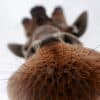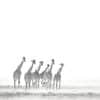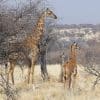The iconic giraffe (Giraffa camelopardalis), one of the world’s most recognisable animals and the tallest land mammal, has moved from ‘Least Concern’ to ‘Vulnerable’ in the newly released International Union for Conservation of Nature (IUCN) Red List of Threatened Species. Widespread across southern and eastern Africa, with smaller isolated populations in west and central Africa, new population surveys estimate an overall 36-40% decline in the giraffe population from approximately 151,702-163,452 in 1985 to 97,562 in 2015. Of the nine currently recognised subspecies of giraffe, five have decreasing populations, whilst three are increasing and one is stable. This updated assessment of giraffe as a species was undertaken by the IUCN Species Survival Commission (SSC) Giraffe & Okapi Specialist Group (GOSG), hosted by Giraffe Conservation Foundation (GCF) and Zoological Society of London (ZSL).
“Whilst giraffe are commonly seen on safari, in the media and in zoos, people – including conservationists – are unaware that these majestic animals are undergoing a silent extinction. With a decline of almost 40% in the last three decades alone, the world’s tallest animal is under severe pressure in some of its core ranges across East, Central and West Africa. As one of the world’s most iconic animals, it is timely that we stick our necks out for giraffe before it is too late,” says Dr. Julian Fennessy, co-chair of the IUCN SSC GOSG, and Director of GCF.
Recent genetic-based research by GCF, Senckenberg Biodiversity and Climate Change Research Centre and other partners, suggests that there are four distinct species of giraffe instead of only one, however, the IUCN currently only recognises giraffe as one species. Should these new genetic findings be confirmed and become widely accepted, this would likely result in three of the four giraffe species being listed as under considerable threat on the IUCN Red List. Taxonomy is just one of many gaps that still exist in our overall understanding of giraffe and highlights that they are indeed Africa’s forgotten megafauna.
Human population growth poses the largest threat to giraffe in Africa today. Habitat loss and changes through expanding agriculture and mining, illegal hunting, increasing human-wildlife conflict, as well as civil unrest, are all factors that are pushing giraffe towards extinction.
However, with GCF giraffe have a strong advocate. During this year alone, GCF and its partners have supported and collaborated on many critical giraffe conservation initiatives including Operation Twiga, a Uganda Wildlife Authority effort to translocate and establish new ranges for the endangered Rothschild’s giraffe in Uganda; a detailed assessment of range and numbers of West African giraffe in collaboration with the Niger government and AVEN; development of an Africa-wide Framework Strategy for giraffe conservation in Africa; and the ongoing development of National Giraffe Conservation Country Profiles for all giraffe range states, which have provided an invaluable baseline for the development of this new IUCN Red Listing.
Steph Fennessy, Director of GCF, points out that “while GCF is a small organisation, we are increasing our reach, working with partners throughout Africa to enhance giraffe conservation on the ground, while at the same time collaborating with partners internationally to rally support and awareness for giraffe, which will ultimately help to save them in the wild in Africa.”
At the IUCN World Conservation Congress in September this year Resolution 008 – Giraffids: reversing the decline of Africa’s iconic megafauna was adopted by the members and called for action to reverse the decline of giraffe in the wild.
Contact us for further information.








Ohh dear is that sad 🙁 i am pray we lost not more Giraffes! a big thanks for all what you doing, for all the hard work with this lovely animals!
Hi everyone, please click here to support my GoFundMe campaign, Im 5 Yrs Old Need Help Save Giraffes: https://www.gofundme.com/36ypkcg?pc=sms_db_co2876_v1
I LOVE GIRAFFES AND THIS MAKES ME SAD I WISH I COULD DO SOMETHING BUT IM ONLY TEN WE NEED TO SAVE THEM